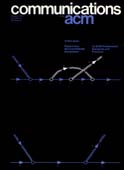August 1971 - Vol. 14 No. 8

Features
Applications of symbol manipulation in theoretical physics
This paper surveys the applications of symbolic computation techniques to problems in theoretical physics. Particular emphasis is placed on applications in quantum electrodynamics where the most activity has occurred.
The Altran system for rational function manipulation — a survey
Altran is a complete system for symbolic computation with rational functions in several variables with integer coefficients. It has been designed and implemented to handle large problems with ease and efficiency. Considerable effort has been spent to ensure a minimum amount of machine dependence in the implementation, thus permitting the system to be installed quickly and easily on a variety of computing machines. In this paper a brief description of the language, run time data structures, and implementation is given.
List tracing in systems allowing multiple cell-types
List-processing systems have each allowed the use of only a single size and configuration of list cell. In this paper a system is described which allows the use of arbitrarily many different sizes and configurations of list cells, possibly not specified until run time.
Algebraic simplification: a guide for the perplexed
Algebraic simplification is examined first from the point of view of a user who needs to comprehend a large expression, and second from the point of view of a designer who wants to construct a useful and efficient system. First we describe various techniques akin to substitution. These techniques can be used to decrease the size of an expression and make it more intelligible to a user. Then we delineate the spectrum of approaches to the design of automatic simplification capabilities in an algebraic manipulation system. Systems are divided into five types. Each type provides different facilities for the manipulation and simplification of expressions. Finally we discuss some of the theoretical results related to algebraic simplification. We describe several positive results about the existence of powerful simplification algorithms and the number-theoretic conjectures on which they rely. Results about the nonexistence of algorithms for certain classes of expressions are included.
Automated algebraic manipulation in celestial mechanics
In this paper we consider some of the applications of automated algebraic manipulation which have been made in celestial mechanics. Particular attention is paid to the use of Poisson series, and a typical problem in perturbation theory is described. The requirements of processors for use in celestial mechanics are considered and compared with those for general manipulation packages. Some future directions for research using these systems are briefly outlined.
To illustrate the relative simplicity of the algorithms required in celestial mechanics, a typical integration problem is considered in an appendix.
General relativity and the application of algebraic manipulative systems
The paper describes some applications of symbolic algebra systems to problems of general relativity including the derivation of the field equations, the Petrov classification of a metric, and the solution of the field equations in the presence of matter in a simple case. Attention is drawn to the strictly algebraic difficulties encountered in this work.
Symbolic integration: the stormy decade
Three approaches to symbolic integration in the 1960's are described. The first, from artificial intelligence, led to Slagle's SAINT and to a large degree to Moses' SIN. The second, from algebraic manipulation, led to Manove's implementation and to Horowitz' and Tobey's reexamination of the Hermite algorithm for integrating rational functions. The third, from mathematics, led to Richardson's proof of the unsolvability of the problem for a class of functions and for Risch's decision procedure for the elementary functions. Generalizations of Risch's algorithm to a class of special functions and programs for solving differential equations and for finding the definite integral are also described.



